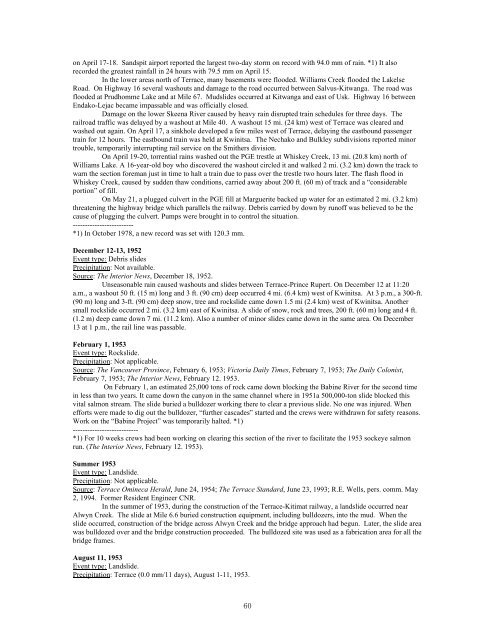HISTORICAL NEWS SEARCH - Government of British Columbia
HISTORICAL NEWS SEARCH - Government of British Columbia
HISTORICAL NEWS SEARCH - Government of British Columbia
You also want an ePaper? Increase the reach of your titles
YUMPU automatically turns print PDFs into web optimized ePapers that Google loves.
on April 17-18. Sandspit airport reported the largest two-day storm on record with 94.0 mm <strong>of</strong> rain. *1) It also<br />
recorded the greatest rainfall in 24 hours with 79.5 mm on April 15.<br />
In the lower areas north <strong>of</strong> Terrace, many basements were flooded. Williams Creek flooded the Lakelse<br />
Road. On Highway 16 several washouts and damage to the road occurred between Salvus-Kitwanga. The road was<br />
flooded at Prudhomme Lake and at Mile 67. Mudslides occurred at Kitwanga and east <strong>of</strong> Usk. Highway 16 between<br />
Endako-Lejac became impassable and was <strong>of</strong>ficially closed.<br />
Damage on the lower Skeena River caused by heavy rain disrupted train schedules for three days. The<br />
railroad traffic was delayed by a washout at Mile 40. A washout 15 mi. (24 km) west <strong>of</strong> Terrace was cleared and<br />
washed out again. On April 17, a sinkhole developed a few miles west <strong>of</strong> Terrace, delaying the eastbound passenger<br />
train for 12 hours. The eastbound train was held at Kwinitsa. The Nechako and Bulkley subdivisions reported minor<br />
trouble, temporarily interrupting rail service on the Smithers division.<br />
On April 19-20, torrential rains washed out the PGE trestle at Whiskey Creek, 13 mi. (20.8 km) north <strong>of</strong><br />
Williams Lake. A 16-year-old boy who discovered the washout circled it and walked 2 mi. (3.2 km) down the track to<br />
warn the section foreman just in time to halt a train due to pass over the trestle two hours later. The flash flood in<br />
Whiskey Creek, caused by sudden thaw conditions, carried away about 200 ft. (60 m) <strong>of</strong> track and a “considerable<br />
portion” <strong>of</strong> fill.<br />
On May 21, a plugged culvert in the PGE fill at Marguerite backed up water for an estimated 2 mi. (3.2 km)<br />
threatening the highway bridge which parallels the railway. Debris carried by down by run<strong>of</strong>f was believed to be the<br />
cause <strong>of</strong> plugging the culvert. Pumps were brought in to control the situation.<br />
-------------------------<br />
*1) In October 1978, a new record was set with 120.3 mm.<br />
December 12-13, 1952<br />
Event type: Debris slides<br />
Precipitation: Not available.<br />
Source: The Interior News, December 18, 1952.<br />
Unseasonable rain caused washouts and slides between Terrace-Prince Rupert. On December 12 at 11:20<br />
a.m., a washout 50 ft. (15 m) long and 3 ft. (90 cm) deep occurred 4 mi. (6.4 km) west <strong>of</strong> Kwinitsa. At 3 p.m., a 300-ft.<br />
(90 m) long and 3-ft. (90 cm) deep snow, tree and rockslide came down 1.5 mi (2.4 km) west <strong>of</strong> Kwinitsa. Another<br />
small rockslide occurred 2 mi. (3.2 km) east <strong>of</strong> Kwinitsa. A slide <strong>of</strong> snow, rock and trees, 200 ft. (60 m) long and 4 ft.<br />
(1.2 m) deep came down 7 mi. (11.2 km). Also a number <strong>of</strong> minor slides came down in the same area. On December<br />
13 at 1 p.m., the rail line was passable.<br />
February 1, 1953<br />
Event type: Rockslide.<br />
Precipitation: Not applicable.<br />
Source: The Vancouver Province, February 6, 1953; Victoria Daily Times, February 7, 1953; The Daily Colonist,<br />
February 7, 1953; The Interior News, February 12. 1953.<br />
On February 1, an estimated 25,000 tons <strong>of</strong> rock came down blocking the Babine River for the second time<br />
in less than two years. It came down the canyon in the same channel where in 1951a 500,000-ton slide blocked this<br />
vital salmon stream. The slide buried a bulldozer working there to clear a previous slide. No one was injured. When<br />
efforts were made to dig out the bulldozer, “further cascades” started and the crews were withdrawn for safety reasons.<br />
Work on the “Babine Project” was temporarily halted. *1)<br />
---------------------------<br />
*1) For 10 weeks crews had been working on clearing this section <strong>of</strong> the river to facilitate the 1953 sockeye salmon<br />
run. (The Interior News, February 12. 1953).<br />
Summer 1953<br />
Event type: Landslide.<br />
Precipitation: Not applicable.<br />
Source: Terrace Omineca Herald, June 24, 1954; The Terrace Standard, June 23, 1993; R.E. Wells, pers. comm. May<br />
2, 1994. Former Resident Engineer CNR.<br />
In the summer <strong>of</strong> 1953, during the construction <strong>of</strong> the Terrace-Kitimat railway, a landslide occurred near<br />
Alwyn Creek. The slide at Mile 6.6 buried construction equipment, including bulldozers, into the mud. When the<br />
slide occurred, construction <strong>of</strong> the bridge across Alwyn Creek and the bridge approach had begun. Later, the slide area<br />
was bulldozed over and the bridge construction proceeded. The bulldozed site was used as a fabrication area for all the<br />
bridge frames.<br />
August 11, 1953<br />
Event type: Landslide.<br />
Precipitation: Terrace (0.0 mm/11 days), August 1-11, 1953.<br />
60

















